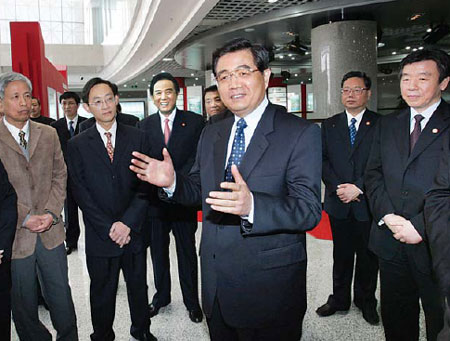
Chinese President Hu Jintao makes an inspection tour of Fujian province in January 2006, encouraging local authorities to accelerate the speed of the economic zone's construction. Zheng Jie
January 2004
During the second session of the 10th People's Congress of Fujian, Lu Zhangong, then governor of the province, initially proposes the construction of an economic zone on the western side of the Taiwan Straits.
March 2004
Two months later, the Fujian delegation to the second session of the 10th National People Congress (NPC) recommends Lu's proposal to the national assembly.
January 2005
The Fujian Committee of the Communist Party of China (CPC) releases an Outline for the Construction of the Economic Zone on the Western Side of the Taiwan Straits and other two related documents, defining the development objectives of the zone. It is pitched as an important growth engine for the Chinese economy and a base for cross-Straits exchange, as well as a frontier platform for the peaceful unification of the motherland.
January 2005
The third session of the 10th People's Congress of Fujian endorses a Decision on Promoting the Construction of the Economic Zone on the Western Side of the Taiwan Straits. This signals the beginning of the construction of the zone.
March 2005
Fujian delegates, attending the third session of the 10th NPC, propose the inclusion of the construction of the zone into the nation's 11th five-year development plan (2006-10).
October 2005
The construction of the economic zone is included in the CPC Central Committee's suggestions for the 11th economic and social development plan.
January 2006
President Hu Jintao visits Fujian and encourages the economic zone to accelerate its development in light of the opportunities offered by increasing cross-Straits economic and cultural exchanges.
March 5, 2006
During the opening ceremony of the fourth session of the 10th NPC, Premier Wen Jiabao states, in his government work report, that the central government will support the development of the economic zone on the western side of the Taiwan Straits and other areas related to Taiwan investments. During this NPC session, the development of the economic zone is officially included in the nation's 11th five-year development plan.
October 2006
The sixth plenary meeting of the 16th Central Committee of the Communist Party of China reiterated its support for the straits economic zone.
January 2007
The fifth session of the People's Congress of Fujian passes the plan for the construction of the economic zone on the western side of the Taiwan Straits, marking the commencement of large-scale construction work on the zone.
October 2007
Construction of the economic zone is widely discussed during the national congress of the Communist Party of China.
November 2007
A third meeting of the eighth provincial committee of the Communist Party of China proposes to build the straits economic zone into a pioneer project for cross-Straits exchange and for "scientific development" in Fujian.
March 2008
The development of the economic zone again features heavily in the work report of the central government during the first session of the 11th NPC.
March 8, 2008
In Beijing, The Ministry of Railways and the provincial government of Fujian sign an agreement promoting a new round of railway construction in the economic zone.
April 2008
The Ministry of Construction approves the Development Plan for the City Cluster on the Western Side of the Straits, as proposed by the Fujian provincial government. This is the second city cluster development plan approved by the State, following the city cluster of Beijing, Tianjin and their neighboring cities in Hebei province.
December 2008
The State Administration for Industry and Commerce issues 15 preferential policies designed to support the development of the economic zone.
May 5, 2009
Premier Wen Jiabao presides over an executive meeting of the State Council, which passes the Decisions on Accelerating the Construction of the Economic Zone on the Western Side of the Taiwan Straits, predicting the zone will become frontier platform boosting industrial and cultural exchanges across the Straits. |

